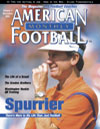AMERICAN FOOTBALL MONTHLY THE #1 RESOURCE FOR FOOTBALL COACHES
Article CategoriesAFM Magazine
|
Putting Nine in the BoxTRINITY UNIVERSITY\'S TIGHT DEFENSEby: Chip Thomas Defensive Coordinator, Trinity College © More from this issue We have been fortunate to achieve an extremely high level of success at Trinity over the past five to seven years. Obviously, there is no one single factor which has allowed us to develop into a consistent winner. Playing with strong special teams, and having an offense which scores 30+ points a game has definitely helped us gain an advantage over our opponents. From the defensive side of the ball, going to our under ("Tight") defense has made all the difference in the world from being a strong defensive unit, to one which can completely shut our opponents' running game down. We have developed into an under defense for a number of reasons.
First, and foremost wa....The full article can only be seen by subscribers.
|
|
|||||||
| HOME |
MAGAZINE |
SUBSCRIBE | ONLINE COLUMNISTS | COACHING VIDEOS |
Copyright 2025, AmericanFootballMonthly.com
All Rights Reserved





